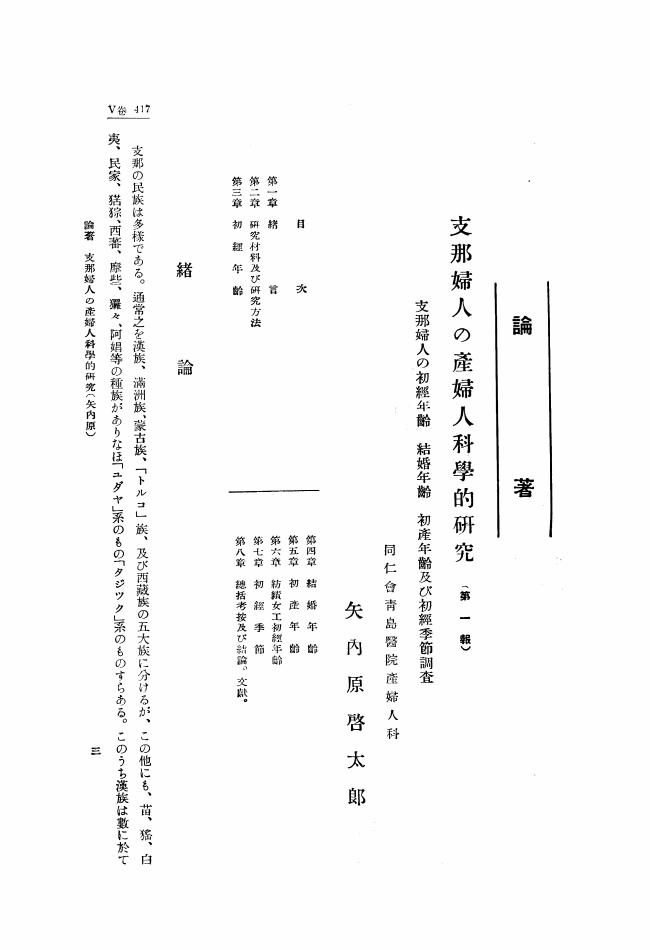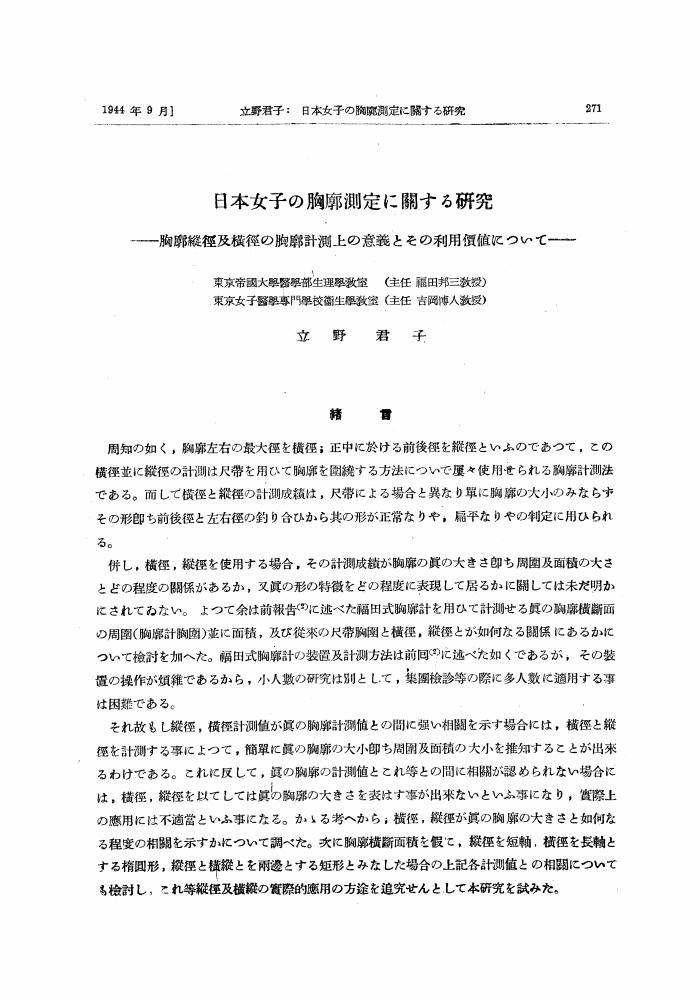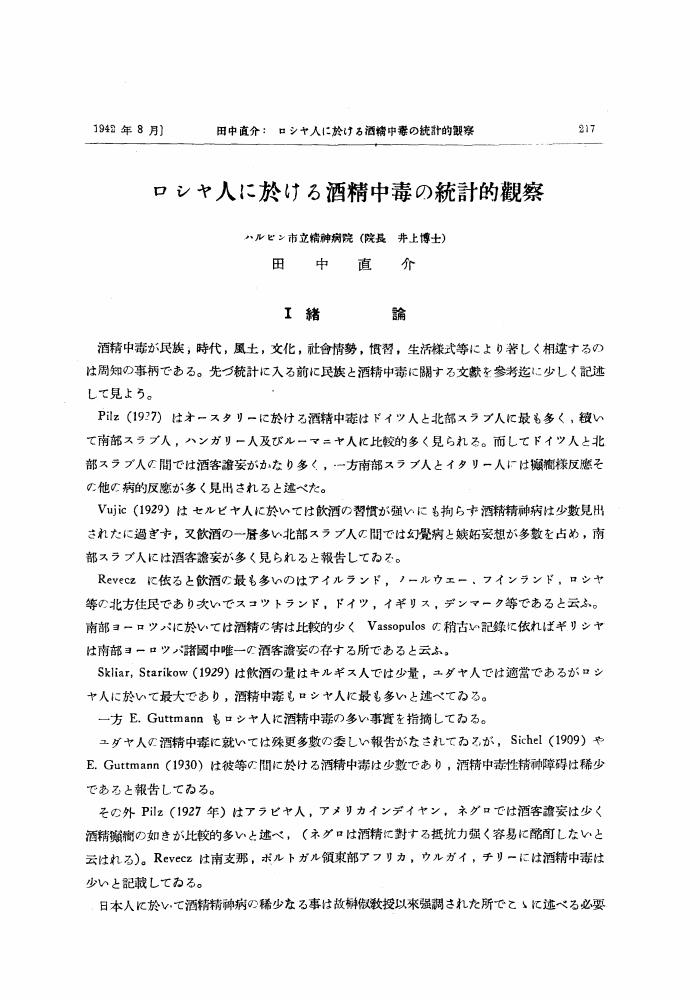1 0 0 0 OA 長野縣上伊那地方に於ける血族結婚に就て
- 著者
- 窪田 義信 福田 邦三 石原 房雄 古川 眞澄 柴 幸恒
- 出版者
- 日本民族衛生学会
- 雑誌
- 民族衛生 (ISSN:03689395)
- 巻号頁・発行日
- vol.17, no.5, pp.114-116,A9, 1950 (Released:2010-11-19)
- 参考文献数
- 3
1.長野縣上伊那の三十一ケ町村に就て現在夫婦の全体調査を行い,血族結婚の濃厚度を檢した.総数で言つて血族結婚15.79%,イトコ同志結婚が9.88%,イトコとイトコの子の結婚が1.71%,マタイトコ同志の結婚が4.19%であつた.2.この人口集團の同系結婚の指標はイトコ同志單位で云つて0.11783.全町村の内で血族結婚の最も高率なのは川島村の28.4(16.43+3.62+8.21)%,同系結婚の指標は0.2029であり,また比較的最も低率なのは高遠町で9.5(6.65+1.21+1.66)%,同系結婚の指標は0.0767であつた.
1 0 0 0 OA 長野縣上伊那地方に於ける血族結婚に就て
- 著者
- 關口 浩 閥口 喜久
- 出版者
- 日本民族衛生学会
- 雑誌
- 民族衛生 (ISSN:03689395)
- 巻号頁・発行日
- vol.17, no.6, pp.117-126,A10, 1951 (Released:2010-11-19)
- 参考文献数
- 2
The frequency of consanguineous marriage is 20.2% or 147 couples among 726. Out of these 147, 68 are marriages between cousins, 10 between children of cousins and cousins, and 69 between second cousins.Husbands and wives consanguineously marrying into the families in Miwa Village mostly originate from the same village (74.7%). Only 1.4% of them come from places outside the Upper Ina Valley. The range of mating is in the average much narrower in consanguineous marriage than otherwise.In this district there was found no indication of decrease of consanguineous marriages. It appears to have increased since 15 or 20 years, as is shown by the following table:Husband or widowerWife or Widow
1 0 0 0 OA 支那婦人の産婦人科學的研究 (第一報)
- 著者
- 矢内原 啓太郎
- 出版者
- 日本民族衛生学会
- 雑誌
- 民族衛生 (ISSN:03689395)
- 巻号頁・発行日
- vol.5, no.5-6, pp.417-438, 1936-12-10 (Released:2010-11-19)
- 参考文献数
- 11
1 0 0 0 地域老人の日常生活動作能力に関する追跡的研究
- 著者
- 芳賀 博 柴田 博 松崎 俊久 安村 誠司
- 出版者
- The Japanese Society of Health and Human Ecology
- 雑誌
- 民族衛生 (ISSN:03689395)
- 巻号頁・発行日
- vol.54, no.5, pp.217-233, 1988
- 被引用文献数
- 41 9
本研究は,初回調査時に比較的健常であった地域在宅老人の10年間の追跡的調査に基づいている.研究の目的は,加齢に伴うADLの変化を明らかにし,さらには,ADLの維持に関わる要因を初回調査時の身体,心理,社会的側面から検索することである. 対象は,昭和51年の初回調査に応じた69~71歳の東京都小金井市在住の男女422名である.このうち,10年後の追跡調査に応じた者は,250名であり,死亡者は102名であった. 得られた主な結果は次のとおりである. 1.10年間に死亡した者は,継続調査群に比べて初回調査時のADL総合点は低い傾向にあった. 2.10年後のADLは,歩行,食事,排泄,入浴,着脱衣のいずれにおいても低下を示し,とくに歩行の低下が最も大きかった. 3.10年後に5項目全てが「半介助」あるいは「介助」に属するいわゆる"寝たきり老人"は,男の3.7%,女の2.1%のみであった.このうち,脳卒中及び骨・関節疾患を有する者を除くと"寝たきり老人"はさらに少なかった(男2.3%,女0.8%). 4.ADLの低下は,女より男に大きい傾向であったが,その差は有意ではなかった. 5.10年後のいわゆる「老化」にともなうADL低下に有意に関連する身体的要因は,高血圧の既往「あり」(男),心電図所見「異常」(男),「肥満」(女)であった. 6.心理的要因では,ベントソ正確数が「低い」(男),身体についての悩み「あり」(女)で有意なADLの低下を認めた. 7.社会的要因では,社会活動性が「低い」ほど有意なADLの低下を示した(男女). 以上の日常生活動作能力の変化に関する予知因子の検討の結果,男女とも社会活動性が10年後のADLの転帰にもっとも関係していた.このことから,社会活動性を維持し,あるいは高めることが日常生活動作能力の保持に役立ち,余命の延長にもつながることが推測された.
1 0 0 0 OA 左利の遺傳
1 0 0 0 OA 日本女子の胸廓測定に關する研究
- 著者
- 立野 君子
- 出版者
- 日本民族衛生学会
- 雑誌
- 民族衛生 (ISSN:03689395)
- 巻号頁・発行日
- vol.12, no.5, pp.271-280, 1944-09-30 (Released:2010-11-19)
- 参考文献数
- 2
1 0 0 0 OA 日本女子の胸廓測定に關する研究
- 著者
- 立野 君子
- 出版者
- 日本民族衛生学会
- 雑誌
- 民族衛生 (ISSN:03689395)
- 巻号頁・発行日
- vol.12, no.5, pp.257-270, 1944-09-30 (Released:2010-11-19)
- 参考文献数
- 4
1 0 0 0 幼児の添い寝 : 心理相談受診者の時代差を中心に
- 著者
- 園部 真美 上田 礼子
- 出版者
- The Japanese Society of Health and Human Ecology
- 雑誌
- 民族衞生 (ISSN:03689395)
- 巻号頁・発行日
- vol.65, no.3, pp.129-135, 1999-05-31
- 被引用文献数
- 1 1
For three-year-old children whose mothers visited a health center in Tokyo for consultation about childrearing problems in 1976 and 1996, their co-sleeping with adult and the related fac tors were examined. The major results were as follows.1. In 1996, the proportion of mothers who co-sleep with toddlers is high among those with jobs, and the mothers who experienced co-sleeping in their own childhood and whose child has evolopmental risk tend to co-sleep.2. Sleeping arrangements, including co-sleeping, of children with developmental risks differ in quality from that of handicapped children.3. Mother's co-sleeping behavior is interrelated with her intention of childcare, information source of childrearing, consultants in neighborhood and the matter of her major interest. From these results, it is suggested that sleeping arrangements of children is associated with factors concerning both mothers and children and it is recognized as an indicator of assessing mother's nurturing behavior and child's developmental risks.
1 0 0 0 OA 某工場に於ける災害の統計的並に臨床的研究 (上)
- 著者
- 若月 俊一
- 出版者
- 日本民族衛生学会
- 雑誌
- 民族衛生 (ISSN:03689395)
- 巻号頁・発行日
- vol.10, no.5, pp.309-335, 1942-11-30 (Released:2010-11-19)
(本論文の内容の一部は昨年十一月日本臨床外科醫會に於いて演説發表せこものなり)
- 著者
- 石田 明
- 出版者
- The Japanese Society of Health and Human Ecology
- 雑誌
- 民族衛生 (ISSN:03689395)
- 巻号頁・発行日
- vol.60, no.5, pp.274-280, 1994
The questionnaires on handedness and a number of biological attributes were asked to 1, 964 Japanese female students to explore the relationships between them. Most items analysed were found to have no relationships to handednes but strong relationships were found between handedness and the ability of physical exercise, the cardio-pulmonary function, the occurrence of urticaria and the thickness of body hair. Ambilaterals were superior to dextrals or sinistrals in the abilities of physical exercise and the cardio-pulmonary function. The inclination to left-handedness was prominent in females whose body hair was thin. The significant linear regression was found for the proportion of dextrals on the frequency of urticaria and on the difference between the number of clockwise hair whorls and that of counterclockwise hair whorls.
1 0 0 0 OA 人口政策が日本の将来人口に与える影響の可視化
- 著者
- 梅崎 昌裕 石川 正敏
- 出版者
- 日本民族衛生学会
- 雑誌
- 民族衛生 (ISSN:03689395)
- 巻号頁・発行日
- vol.80, no.1, pp.6-11, 2014 (Released:2014-03-28)
- 参考文献数
- 3
The latest population projection for Japan showed that during the next 50 years, the dependency ratio will drastically increase from 0.58 (2010) to 0.94 (2060) and that the population will decrease from 128 million (2010) to 87 million (2060). There is concern that burdens placed upon the working-age population will increase and that the social security system of the nation might eventually collapse. We report here the results of population projections under four scenarios of changes in vital statistics rates that reflect the current demographic policies in Japan. These four scenarios assume that specific vital statistics rates change as follows. Scenario 1 : The total fertility rate will increase to 2.1 (replacement level) in 2010. Scenario 2 : The in-migration rate at 18 years of age will increase to 0.1. Scenario 3 : The start of old age is redefined as 70 years. Scenario 4 : Age-specific mortality at age 65 years or older will double. Scenarios 1 and 2 mitigate the population decrease, but Scenario 1 increases the dependency ratio for the initial 40 years. Scenario 3 drastically decreases the dependency ratio without affecting the population size or structure. Scenario 4 suppresses the increase in the dependency ratio, but decreases the population size. If all four scenarios occurred simultaneously, the dependency ratio in 2060 would remain at the level observed in 2005.
1 0 0 0 OA 癌の罹病調査について
- 著者
- 大森 暢久 岸 篤 岡部 五成 長田 宗憲 浅見 正彦 平山 雄
- 出版者
- 日本民族衛生学会
- 雑誌
- 民族衛生 (ISSN:03689395)
- 巻号頁・発行日
- vol.25, no.5, pp.644-648,A40, 1959 (Released:2010-11-19)
- 参考文献数
- 6
In order to investigate the actual state of cancer within the jurisdiction of the Kawagoe Helth Centre of the Saitama Prefecture, we have visited all the 110 hospitals and clinics within the jurisdiction, under the cooperation of the Doctors' Ass'n., and the Health Centre. We have not only inquired of the doctors, but have also gone through the protocols of the patients who have come during the investigation period, and we have chosen those who were diagnosed as cancer or malignant ulcer, making our observations according to sex, age, and disease types. We have calculated the death rate by comparing the contraction percentage of cancer, the prevalence rate, and the death certificate ; and have compared it with the figures of various parts of the U.S.A., and the Miyagi, Okayama, and Saitama Prefectures. Furthermore, the monthly survival rate was obtained, and the drawing up of basic data was attempted in order to devise measures of the prevention of cancer.
1 0 0 0 出生季節分布の長期的変動と分布の成因の検討
- 著者
- 志村 正子 三浦 悌二
- 出版者
- The Japanese Society of Health and Human Ecology
- 雑誌
- 民族衛生 (ISSN:03689395)
- 巻号頁・発行日
- vol.44, no.4, pp.165-174, 1978
Changes in birth distribution pattern during a few centuries were investigated in both Japan and the USA, using various forms of records. Regional differences in seasonal birth distribution, and their connection with birth rates and marriage seasons were also studied. The following conclusions were drawn. 1) From the second half of the 19th century to the first half of the 1960's, seasonal distribution of births in Tokyo and Osaka showed a fluctuating pattern with a peak from January to March and a trough between May and August. Most variations during that period were in the amplitude of the basic pattern. 2) Old registration books of parishoners known as 'Ninbetsu-cho' of three towns in Osaka City revealed a peculiar pattern with a sharp peak between November and December, ( October and November of the lunar calender) from 1755 to 1867. 3) Japanese birth distribution became less noticeable in the 1960's and the 1970's with very low peak between July and August similar to that formed in the USA. 4) In USA, there is a secular change of shifts of peaks in different periods. The typical pattern with a peak between Aug. and Sep. can be seen from the second half of the 18th century to the first half of the 19th century and again after 1930. During certain periods since the 17th century, different patterns are apparent: e. g. a wide peak between May and September until the 1970's, or a pattern with two peaks in spring and autumn from the second half of the century until the 1920's. 5) Regional differences of the birth distribution in Japan gradually decreased and have reached uniformity throughout Japan. (6) As for the relationships between birth seasonality and regional birth rates, regional birth rates fell in summer, becoming lower as one travels south. 7) As for the relationship between birth seasonality and annual birth rate, a distinct difference was seen in the peak season of Jan.-Mar., and the birth rate in the trough season of May-July changed little until World War II when contraception became popular in Japan. 8) Prior to World War II the seasonal distribution of marriages in Japan was typified by peaks in spring. After the Wax it changed to a pattern with peaks in both spring and late autumn. Seasonal differences of marriages increased, in contrast to birth patterns. 9) Comparing the distribution of marriage ceremonies and registrations after World War II in Japan, seasonal variance was larger for ceremonies than registrations. The marriage registration peak shifted ahead one or two months. This suggests that most marriages were registered several months later than ceremonies. In the 1970's, however, this difference was reduced. 10) It seems worthwhile to consider the possibility that certain seasonal biological suppressing factors varying in period and by region may be responsible for the distributional birth pattern.
1 0 0 0 マーシヤル群島原住民 (ミクロネシヤ族) の指紋研究
- 著者
- 鮫島 宗雄
- 出版者
- The Japanese Society of Health and Human Ecology
- 雑誌
- 民族衛生 (ISSN:03689395)
- 巻号頁・発行日
- vol.6, no.5, pp.395-409,en1, 1938
Es ist allgemein anerkannt, dass die Fingerabdrücke interessante Versehiedenheiten aufweisen, nicht allein im einzelnen sondern auch ethnographisch. Zum Beitrage der anthropologischen der Mikrônesier, machte ich Untersuchungen über Erscheinungen von Fingerabdrücken an je 400 Hände von Männern und Frauen der Bewohner der Marshall-Inseln.<BR>Bei den Fingerabdruck-Formeln der Marsall-Insulaner ist die Häufigkeit von wwwww am höchsten (I4.8±I.77, I4.0±I.73), es gleicht sih meist dem der Ostasiaten.<BR>Die Häufigkeit von jeden Fingerabdruck-Typen im Ganzen und der Fingerabdruck-Index lässt sich folgendermassen konstatieren:<BR>A R U W Fingerabdruck-Index<BR>3.0±0.38 1.8±0.30 45.3±1.11 49.9±1.12. 105 94<BR>2.3±0.28 0.7±0.19 48.1±1.1 2 49.0±1.12 100.41.<BR>nämlich, w ist am häufigsten, A und R weniger als bei der weissen Rssse, Fingerabdruck-Index ist gross, und weisst die Natur bei allgemeinen Mongolrassen auf.<BR>Ferner, bei Summierung meiner ausführlichen Beobachturgen über die häufigeit an jeden von jeden Finger, jeden Hande und Geschlecht, HAi and R sind am meisten aut die Zeigefinger, U auf dem kleinen Finger, w kommt am häufigsten auf Ringfinger vor. Und von Finger-Seiten ausgesehen, auf Daumen, Zeigefinger und Ringfinger ist w am häutigsten and auf Mittelfinger und kleinen Finger ist U am häufigsten. Von Hand-Seiten ausgesehen, erscheint U am häufigsten auf der linken Hand, während auf der rechten Hand w mehr vorkommt. Di geschlechtlichen Unterschiede sind im Allgemeinen nicht bemerkbar, aber bei häufiges Erscheinen von R Typen, Manner übertreffen Frauen in jedem Fall. Es ist verursacht die ausserordentliche hohe Prozentzahl von R Typen auf der Manner rechten Zeigefinger
1 0 0 0 アイヌの指紋掌紋の研究:第一報沙流地方アイヌの指紋に就て
- 著者
- 岡田 正夫
- 出版者
- The Japanese Society of Health and Human Ecology
- 雑誌
- 民族衛生 (ISSN:03689395)
- 巻号頁・発行日
- vol.4, no.5, pp.453-462,en3, 1935
- 被引用文献数
- 1
Dr Verfasser durchmustert die Fingerabdrücke von Aino, welche im Juli 1934 im Dorf <I>Piratori</I>, Hokkaido, von Verfasser selbst angefertigt wurden, und teilt folgendes mit.<BR>Das betreffende Material besteht aus 1853 Fingerabdrücke von 58 erwachsmen Aino-Männern und 130 ebensolchen Weibern, welche fast ausnahmslos auf dem <I>Saru</I> Gebiete, Provinz Hidaka bewohnen, und angeblich sowie somatoskopisch rein zu sein schienen.<BR>Die Ergebnisse sind im Detail auf den Tabellen 1-6 zusammengestellt.<BR>Im Vergleich mit einer früheren Arbeit von Prof. Hasebe ('18) welche is Heute die einzige Mitteilung über das Hautleisten von Aino gewesenb ist, stellt sich kein gründlicher Unterschied heraus. Bei Aino treten U-Muster häufiger, dagegen W-Muster seltener als bei Japaner auf. Sonstige Mustertypen zeigen kelne merkwürdigen Unterschiede zwischen den beiden Rassen. Demgemass fällt der Digital-Index (nach Furuhata, W (%) /U (%) R (%). -100) von Aino ausserhalb oder an der Grenze de=r Variationsbreite des betreffenden Index von Japaner.[nämlich : 56.0, : 42.1 bei Aino im gegensatz durchschnitt 63. 52, and Variationsbreite 78.00-55.88 bei Japaner nach Hirai ('28).]<BR>Bilaterale und geschlechtliche Häufigkeitsunterschiede der 4 Hauptmustertypen bei A. no unter sich sind auf der Tabelle 3 ersichtlich.<BR>Was die Musterkonibination an den 5 Fingern anbelangt, so ist die Formel uuuuu am häufigsten bi beiden Geschlechtern vertreten. Die Formel wwwww, die sich um eine der wichtigsten Kombinationen bei Japaner handelt, tritt hier dagegen stark zurück, nähmlich U5/W5: 7.0, 7.6, 7.5 bei Aino gegenüber 1.09 nach Angaben Prof. Hasebe. oder 1.11 nach Takeuchi bei Japaner.
1 0 0 0 OA ロシヤ人に於ける酒精中毒の統計的觀察
- 著者
- 田中 直介
- 出版者
- 日本民族衛生学会
- 雑誌
- 民族衛生 (ISSN:03689395)
- 巻号頁・発行日
- vol.10, no.4, pp.217-227, 1942-08-31 (Released:2010-11-19)
- 参考文献数
- 12
1 0 0 0 OA 力士の體型遺傳に就て
- 著者
- 荒谷 壽治
- 出版者
- 日本民族衛生学会
- 雑誌
- 民族衛生 (ISSN:03689395)
- 巻号頁・発行日
- vol.7, no.2, pp.83-97, 1937-06-30 (Released:2010-11-19)
- 参考文献数
- 21
1 0 0 0 OA ラオス伝統的民謡「ラム」を活用した健康教育の試み
- 著者
- 吉田 いつこ 小林 敏生 寺岡 幸子 虫明 悦生 Kongsap AKKHAVONG Amphoy SIHAVONG Dalaphone SITTHIDETH Bang-on NISAYGNANG 門司 和彦
- 出版者
- 日本民族衛生学会
- 雑誌
- 民族衛生 (ISSN:03689395)
- 巻号頁・発行日
- vol.77, no.3, pp.109-120, 2011 (Released:2011-07-25)
- 参考文献数
- 24
The purpose of this study is to clarify the effectiveness and significance of the health education method through using traditional folk song “Lam” in Lao PDR.The study was conducted at a village in Vientiane city with 48 participants. Firstly we collected quantitative data by questionnaire survey and then conducted group interview after listening “Lam” for HIV/AIDS prevention. The qualitative data was analyzed by basic procedure of KJ method.The result showed that the participants with older than 20-year old (p<0.05) and lower education (p<0.05) tended to prefer “Lam”. Through the qualitative analysis, eight categories were extracted ; 1) Interest for Lam talking about HIV/AIDS, 2) Perception for a risky sexual behavior, 3) Knowledge on the HIV/AIDS infection routes, 4) Commitment for HIV/AIDS prevention, 5) Needs for the health education methods, 6) Suggestion for HIV/AIDS education, 7) Consortium with people living with HIV/AIDS, and 8) Characteristics of Lam and its advantages. After listening Lam, the participants received knowledge about HIV/AIDS and formed attitude for HIV/AIDS prevention. This process was influenced by the characteristics of Lam and its advantage such as entertainment, educational function and traditional communication.These result suggested that Lam which has entertainment and educational function can be utilized as an effective media for Lao people to improve knowledge and promote better attitude and behavior. In addition, the educational method through using traditional communication media such as Lam might be effective for the people to memorize and communicate information.
1 0 0 0 自殺に用いられる薬毒物と出版物による影響に関する研究
- 著者
- 後藤 京子 杉本 侃
- 出版者
- The Japanese Society of Health and Human Ecology
- 雑誌
- 民族衞生 (ISSN:03689395)
- 巻号頁・発行日
- vol.62, no.2, pp.53-64, 1996-03-31
- 被引用文献数
- 5
The Japan Poison Information Center (JPIC) received 205, 199 inquiries from citizens and medical personnel for 5 years from April, 1989 to March, 1995. And, the number of inquiries concerning with suicide in those was 5, 778. In July 1993, the book named the Suicidal Manual were published in Japan and since then, the inquiries concerning with suicide attempts have increased. So, I analyzed these data about implicated products and contrasted the data received before the publication of the manual to the data received after that on purpose to make clear the affection of the Suicidal Manual. In regard to the substance that was selected in suicide attempts cases, teen-ager and the twenties tend to use medicines, especially over-the-counter drugs and older people tend to use agricultural chemicals. After the book was published, the number of inquiries about some over-the-counter drugs that were shown as appropriate way for easy and painless death in the book had increased. So, it is very important to give the young people the information of drug toxicity and appropriate management of drugs to decrease the influence of the book.
1 0 0 0 中国朝鮮族児童・生徒の骨成熟と体型の関係
- 著者
- 呉 小寒 高井 省三
- 出版者
- The Japanese Society of Health and Human Ecology
- 雑誌
- 民族衞生 (ISSN:03689395)
- 巻号頁・発行日
- vol.71, no.1, pp.25-34, 2005-01-31
- 被引用文献数
- 1 1
The somatotype and skeletal maturity of 801 Korean-Chinese children aged 11.60-18.11 years in Longjing of Northern China have been assessed by the Heath-Carter and TW2/TW3 methods. Their physique was similar to that of Japanese children . The endomorphy was prominent during 12 to 16 years in girls. The mesomorphy and the ectomorphy were remarkable dur ing 14 to 16 years in boys. The typical somatotype was the mesomorphy for boys and was the endomorphy for girls. Their TW3 skeletal maturities were also similar to that for Japanese children, but slightly differed from the recent European standards. This study clarified that endomorphic and mesomorphic children were early maturer skeletally, while ectomorphic children were late maturer skeletally for the sexes.





